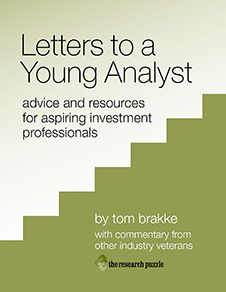
- Wednesday, January 9th, 2013
- different speeds
-
It is the start of earnings season, the perfect time to pick up the ongoing series on equity research.the research puzzle | This PDF is updated as new postings in the series are completed. For some, what is normally a frenetic pace of research activity goes into hyperdrive with the release of quarterly results.
If you are a sell-side analyst, you listen to an earnings call, work on your model, do a report for publication in the morning, maybe get a little sleep, and get up to start communicating to the members of your firm, your clients, and — if you have a certain stature — a television audience. You probably have a junior analyst or even a team to help you, but there’s plenty to do. And if more than one firm reports in an afternoon, you do it all twice or three times, perhaps without the sleep.
Or maybe you are a buy-side analyst, let’s say for a hedge fund that is known to trade heavily. The news comes fast and furious: Reports from the company (and spin from the company) and opinions from all corners. You are fielding the mess of it, plus trying to analyze the developments and communicate effectively about them and your point of view.the research puzzle | Since your job is, as we learned earlier in the series, “analysis plus communication.”
In either of those positions — or if you are a portfolio manager dealing with a broad range of current and potential investments — it might seem that speed is always of the essence, even though in today’s world you’re not likely to add much value through speed. You are propelled along at the pace of the business, whether that results in good decisions or not.
For the leaders of investment organizations, those realities raise a question: Does your strategy really require you to play the game as everyone else does, to run at the same speed at which the market runs? The chances are parts of your process are vestiges of a time gone by. Rethinking them could be liberating and fruitful.
To consider an even more important question, let’s say you are a director of research, with a staff of qualified analysts. They have different areas of coverage, but essentially identical job descriptions and goals. Thus, you have a lot of analytical horsepower, but it all operates at the same speed and pretty much in the same way.
Which is bad, not good.
The structure is principally built for one kind of person, who operates in a particular fashion and attempts in all ways to stay in sync with the market. Yet some of the most brilliant investors frame analyses in unique ways and operate at different speeds than the rest of us. You probably either force them to conform or, more likely, you don’t hire them in the first place.
How much better it would be if your research strategy resulted not in a sameness of roles and activity, but a differentiation of them in ways that took full advantage of the talent available and met the true needs of your firm. That person that operates a different speed, who is frustrating you now, may be the key to your future.FlowingData | A 2010 posting of mine, which talked about “those darn analysts,” addressed the issue of the functional straightjackets analysts are in. This link, though, is just a quick visual trigger for thoughts of customization that you might have.
Please note: The third member of the “research puzzle” family, a mini-blog with shorter updates, was recently introduced.research puzzle pieces | The site is on the Tumblr platform, so you can follow it there or via RSS. There are no email notifications available.
